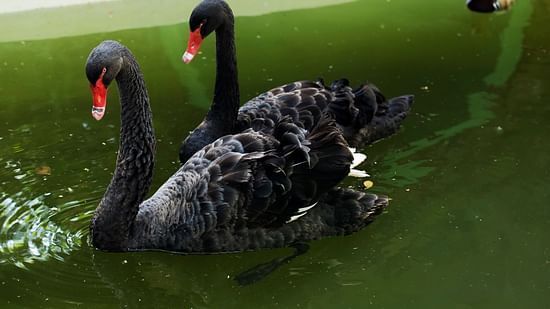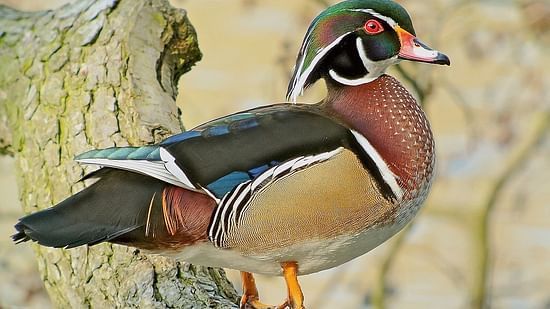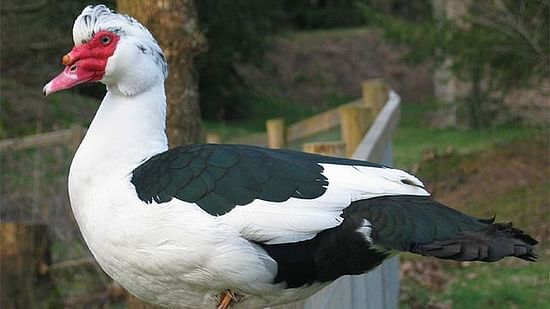
Black-Necked Swan:
Scientific Name: Cygnus melancoryphus
As the name suggests, the black-necked swan has a definable long black neck with a red knob or carbuncle at the end of its upper mandible, that grows in size during breeding season. These species of swans have short wingspans. However, they can fly faster than other swan species. They have a vegetarian diet composed mainly of aquatic plants. With a lifespan of upto 30 years, these swans are found in the southern part of South America including the Falkland Islands where they find shelter in the swamps, freshwater marshes, brackish lagoons and shallow lakes.
As the name suggests, the black-necked swan has a definable long black neck with a red knob or carbuncle at the end of its upper mandible, that grows in size during breeding season. These species of swans have short wingspans. However, they can fly faster than other swan species. They have a vegetarian diet composed mainly of aquatic plants. With a lifespan of upto 30 years, these swans are found in the southern part of South America including the Falkland Islands where they find shelter in the swamps, freshwater marshes, brackish lagoons and shallow lakes.

Black Swan:
Scientific Name: Cygnus atratus
Out of the three swan species found in the southern hemisphere, the black swan is unique because of its full black body which gives it a mysterious aura. They have a ruffled appearance because of their crinkled feathers. These birds are strong fliers and their flocks tend to fly in a ‘V’ formation while their wings create a whistling noise. The call of the black swan is similar to a high-pitched, musical baying, bugling or like a trumpet call.
Out of the three swan species found in the southern hemisphere, the black swan is unique because of its full black body which gives it a mysterious aura. They have a ruffled appearance because of their crinkled feathers. These birds are strong fliers and their flocks tend to fly in a ‘V’ formation while their wings create a whistling noise. The call of the black swan is similar to a high-pitched, musical baying, bugling or like a trumpet call.

Wood Duck or Carolina Duck:
Scientific name: Aix sponsa
The wood duck is known for its pretty appearance. The male population sports an iridescent chestnut colour with patches of green and ornate patterns on their feathers. The females have a characteristic delicate white pattern around their eyes. They are found in wooded swamps where they build nests in the holes of trees or in nest boxes around lakes. Their claws are suited to grip bark or perch upon the branches of trees. These birds are native to the region between California and British Columbia and are also found in between Montana east to Nova Scotia, to the south of Texas and Florida.
The wood duck is known for its pretty appearance. The male population sports an iridescent chestnut colour with patches of green and ornate patterns on their feathers. The females have a characteristic delicate white pattern around their eyes. They are found in wooded swamps where they build nests in the holes of trees or in nest boxes around lakes. Their claws are suited to grip bark or perch upon the branches of trees. These birds are native to the region between California and British Columbia and are also found in between Montana east to Nova Scotia, to the south of Texas and Florida.

Mandarin Duck:
Scientific name: Aix galericulata
This perching breed of duck is native to East Asia. The average mandarin duck can grow up to 49 cm in length with a wingspan of 65 to 75 cm. It is a close relative of the North American wood duck. The breeding grounds for mandarin ducks in the wild are often found in dense woods near shallow lakes, marshes or ponds. Their egg-laying season is generally during spring. While many of these birds are found in the freshwater during winters, these ducks can be spotted near the coastal lagoons and estuaries too. Their diet comprises plants, and seeds, especially beech mast. They also feed on snails, insects and small fishes from time to time. The changes in their diet varies from season to season. All the small habits of this unique species of bird can be observed at EsselWorld Bird Park
This perching breed of duck is native to East Asia. The average mandarin duck can grow up to 49 cm in length with a wingspan of 65 to 75 cm. It is a close relative of the North American wood duck. The breeding grounds for mandarin ducks in the wild are often found in dense woods near shallow lakes, marshes or ponds. Their egg-laying season is generally during spring. While many of these birds are found in the freshwater during winters, these ducks can be spotted near the coastal lagoons and estuaries too. Their diet comprises plants, and seeds, especially beech mast. They also feed on snails, insects and small fishes from time to time. The changes in their diet varies from season to season. All the small habits of this unique species of bird can be observed at EsselWorld Bird Park

Muscovy Duck:
Scientific name: Cairina moschata
The muscovy duck is a large duck endemic to Mexico, Central, and South America. The males can grow upto an average length of 76 cm, weighing almost 7 kg. The females are comparatively smaller and are roughly half the size. The bird is majorly black and white. The back feathers of the males are more glossy than those of the females. Despite being a tropical bird, the muscovy duck adapts well to cooler temperatures and can thrive even at −12 °C. They prefer habitats near or on the water, surrounded by dense vegetation and large trees. Examples of such habitats include rivers, brackish coastal wetlands, ponds and wooded swamps. These omnivorous birds consume small fishes, crustaceans, termites, millipedes, small reptiles, tree roots, leaves, stems as well as terrestrial and aquatic plant seeds including agricultural crops.
The muscovy duck is a large duck endemic to Mexico, Central, and South America. The males can grow upto an average length of 76 cm, weighing almost 7 kg. The females are comparatively smaller and are roughly half the size. The bird is majorly black and white. The back feathers of the males are more glossy than those of the females. Despite being a tropical bird, the muscovy duck adapts well to cooler temperatures and can thrive even at −12 °C. They prefer habitats near or on the water, surrounded by dense vegetation and large trees. Examples of such habitats include rivers, brackish coastal wetlands, ponds and wooded swamps. These omnivorous birds consume small fishes, crustaceans, termites, millipedes, small reptiles, tree roots, leaves, stems as well as terrestrial and aquatic plant seeds including agricultural crops.

Cape Barren Goose:
Scientific name: Cereopsis novaehollandiae
The cape barren goose hails from Australia and is unique in terms of its body shape and size. These bulky birds have a uniformly coloured grey plumage with rounding black spots. They have pink legs with black feet. They can grow up to 75-100 cms. The males are comparatively larger than the females. They graze on lands to search for food and rarely swim. These species are the rarest of their kind making our Bird Park one of the best bird parks in India!
The cape barren goose hails from Australia and is unique in terms of its body shape and size. These bulky birds have a uniformly coloured grey plumage with rounding black spots. They have pink legs with black feet. They can grow up to 75-100 cms. The males are comparatively larger than the females. They graze on lands to search for food and rarely swim. These species are the rarest of their kind making our Bird Park one of the best bird parks in India!
Come and meet our friends who live in and around water. Have a fulfilling time at this tourist hotspot in Mumbai!
Visit our other attraction:
 |